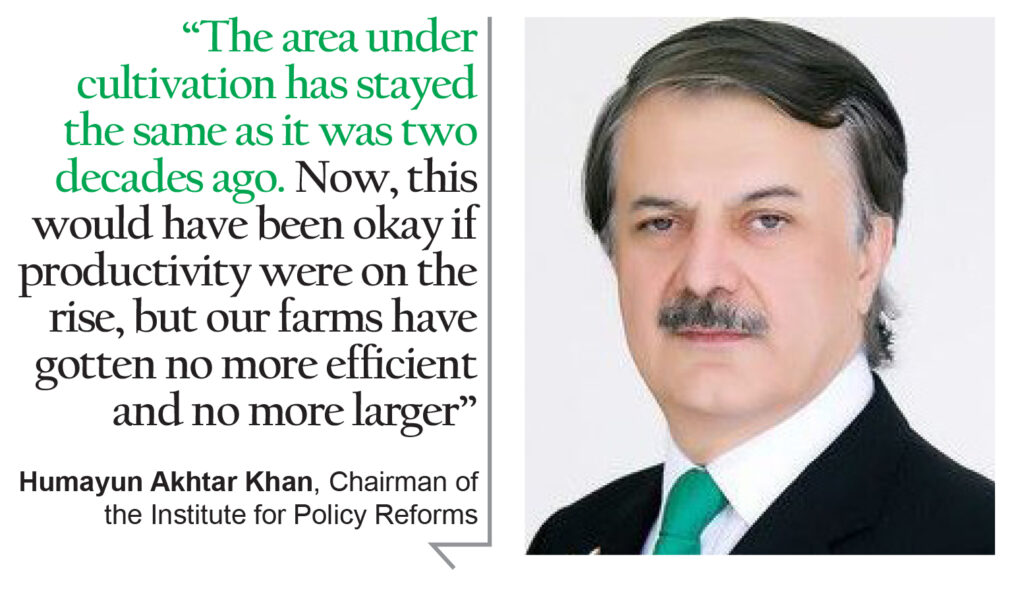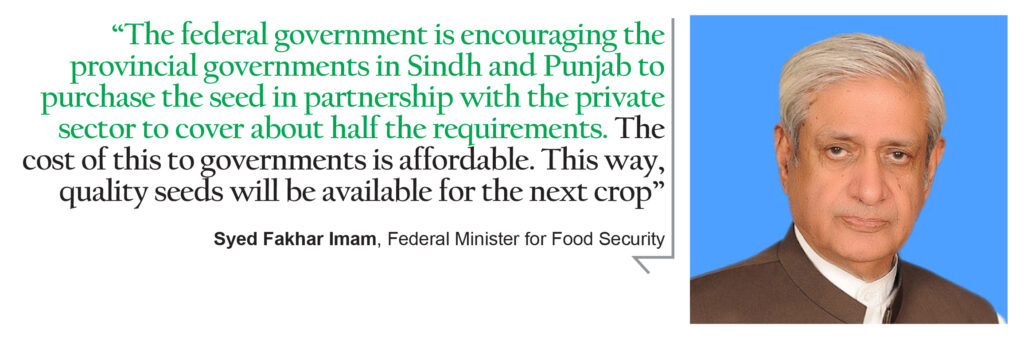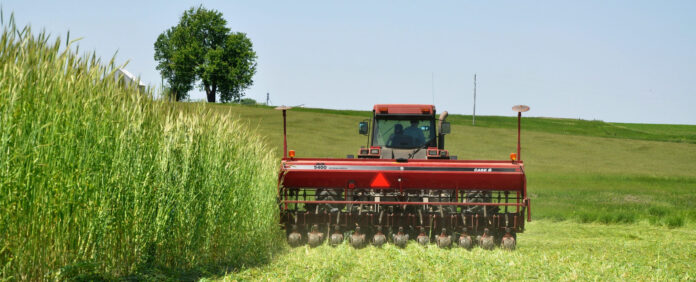Even as we battle in the throes of the coronavirus pandemic, something most Pakistanis will not know is that we have been fighting another virus for more than a decade now. The ‘curl leaf virus’ is a pathogenic virus that affects cotton plants, causing its leaves to curl upwards and growth to become stunted, resulting in significantly lower yields.
Despite cotton and textiles being a major export for Pakistan, successive governments have been unable to combat the virus, leaving cotton farmers frustrated and complaining. This inability is testament to the neglect that the agriculture sector has seen in the country.
The government often describes Pakistan as an agrarian society, a fact that is repetitively drilled into our heads by social studies textbooks. Yet, the agricultural sector remains starved of attention. Even as the government announced a multi-billion rupee rescue and relief package for textile mills, the farmers who grow the cotton for those mills were conveniently ignored.
And without a powerful lobby like the All Pakistan Textile Mills Association (APTMA) to back them and raise a ruckus in the media, is it any surprise that farmers do not get anywhere and remain largely ignored?
The latest news, however, has been hopeful, with reports surfacing that the government has announced the Prime Ministers Agriculture Emergency Program worth a whopping Rs277 billion. After decades, there is hope that a meaningful reversal in the fortunes of the agriculture sector might be on the cards. Naturally, the relief package has drawn attention, and was a subject of discussion along with the plight of agriculture at a recent webinar attended by people in powerful corridors. But the question remains, even with the money, how deep do Pakistan’s agricultural issues go?
The IPR webinar
The woes of the agricultural community and the issues that haunt this sector prompted the recent webinar held this week by the Institute for Policy Reforms’ (IPR), a pro-Establishment think tank run by Humayun Akhtar Khan and some other veterans of the Musharraf Administration. The webinar was supposed to get powerful movers and shakers together and ask them to be part of the conversation related to agriculture, which are usually left to farmers and the raw material users.

The conclusions were stark for the sector, though judging by what the participants of the webinar thought were problems, perhaps a bigger problem for the sector is one of mental framework even for those who mean it well.
For starters, the participants – who were all experts on agriculture or agricultural economics – thought that one of the biggest problems facing the agriculture sector is that it is unable to attract enough foreign aid, a reflection of the old Pakistani bureaucratic beggar mentality that nothing can be done without a handout from foreign countries. As if Pakistan does not have the resources to better its own condition.
They pointed to the fact that of the grants that it does manage to get, it is rare that they are invested in a way that increases productive capacity to produce exportable goods. Pakistan’s research capabilities have lagged so far behind that it is often impossible for the government to be able to ascertain an appropriate policy course of action.
Because of its large agricultural landmass and population, Pakistan has thus far managed to skate by with its existing natural resources. However, decades of ignoring the problems have brought us here, where the country as a whole is still unable to fight the ‘curl leaf virus’ in 2020.
“We have been unable to adequately deal with the virus affecting cotton, or even the harm done to all crops by insects. Is it any surprise then that many indicators reflect the sector’s grim reality,” said Pakistan Tehreek-i-Insaf (PTI) leader and IPR Chairman, Humayun Akhtar Khan on the occasion.
“The area under cultivation has stayed the same as it was two decades ago. Now, this would have been okay if productivity were on the rise, but our farms have gotten no more efficient and no more larger,” he added.
The production of wheat per hectare has not grown, and cotton productivity has fallen. So far, there has not been a single meaningful discussion on the effect of climate change or food security. There has not been so much as a conversation about how to manage agriculture in a fundamentally changing world.
“Agriculture suffers from underinvestment, flawed policies and a lack of connection between research and policy. In times of crises, we offer Band-Aid solutions, but avoid studying the systemic issues that affect agriculture. However, it is not a lost cause yet,” said Humayun Akhtar Khan.
According to Syed Fakhar Imam, the federal minister for national food security, Pakistan needs another major breakthrough in agriculture. “Until the 1990s, Pakistan’s rates of growth were close to 4%, continuously on the average for nearly two decades,” he said.
“Our major breakthrough in agriculture came when we had a paradigm shift both in our wheat production with the assistance of Dr Norman E Borlaug and with IRRI [International Rice Research Institute] in the cultivation of rice. That went up by two and half times our traditional,” he added.
“After 1966 things changed because of two specific elements: the introduction of the short stature mexipak wheat breed, and the use of chemical fertiliser, and optimal use of application of water with the fertilizer. This changed the entire paradigm [and significantly increased crop yields]. And since then, there has not been a second shift in the paradigm.”
Five major crops
Essentially, Pakistan focuses on five major crops. Of these, the most significant one is wheat, which makes up 36% of agricultural land being used. The other four are rice, sugarcane, cotton and maize. The first four of these are all very traditional crops that grow well in Pakistan’s climate. However, the big breakthrough of the past few decades has been the growing of maize.

Maize only appeared on the scene somewhere in the last 12 years. About 12-14 years ago, it accounted for only 1.5 million tons. This number has now gone up to 6.7 million tons, primarily because the poultry industry depends on it. It is also worth remembering that Pakistan’s overall growth has not been this significant, so there has definitely been a change in focus among growers towards maize.
However, while it is a bit of a success story, maize is also a great example of everything that is wrong with the growing process in Pakistan. For starters, most of the maize or corn seeds used by farmers are imported through multi-national companies (MNCs), and not necessarily indigenous to the areas they are planted. Domestic seed production has been one major area in which Pakistan has failed to make any progress
Even the curl leaf virus referred to in the beginning could have been solved using modern seed technology techniques. Many countries, including in both Africa and Asia, have managed to overcome this virus. But Pakistan’s antiquated, local seed technology and treatment has meant the disease persists and affects yields to this day.
In total, Pakistan needs about 42-45 thousand tons of seeds a year. There was a time when the Punjab Seed Corporation was providing reasonably standardised seed. This met about 30-35% of Pakistan’s seed requirement.
“The federal government is encouraging the provincial governments in Sindh and Punjab to purchase the seed in partnership with the private sector to cover about half the requirements,” suggests Fakhar Imam. “The cost of this to governments is affordable. This way, quality seeds will be available for the next crop. The above is for several crops. We should also do the same with wheat.”
Imam believes that our entire research system needs to change. He said that international specialists will soon appraise, evaluate and analyze the government’s research systems in their areas of specialisation, with a particular emphasis on the ability to generate data to analyse and solve local problems. Until Pakistan actually has cutting edge data that it can use to focus on problems and solve them, the agricultural sector will go nowhere.
This is where the Catch-22 of all Pakistani problems comes in. The country needs our agricultural sector to be strong not just for food security, but because it is a significant export for us. However, to improve the sector, the country need machines, pesticides, and different kinds of fertiliser. Out of all these major inputs, very little is manufactured domestically, and all of them are imported. So to improve agriculture, until we can manufacture, we will be forced to import.
The heart of the problem
Clearly there is much to be talked about in regards to how the agricultural sector has been treated in Pakistan over the decades. The neglect and the hodge podge, half-hearted attempts at fixing it have not made things better. We also have very little accurate data to determine specific, and technical problems that the country is facing in this regard. However, experts have weighed in on what we do know.
For Dr Iqrar A. Khan, former Vice Chancellor of the University of Agriculture in Faisalabad, Pakistan’s biggest challenge is small farm size and fragmentation. “The bulk of our present land holdings does not allow absorption of available technology. The research available cannot be utilized by small farm holders,” he said.
“Due to large scale urbanization, parts of the country are threatened with desertification. Range lands are being overgrazed and salinity is a continuing threat to output. This is happening because of excessive groundwater mining.”

Water is an endemic issue. Investment in on-farm water management and large storages have yet to show results on ground. The need of the hour is a high-efficiency irrigation system, what we have instead is the traditional gravity operated, analog irrigation system that is no longer enough, especially with smaller land holdings.
Dr Khan suggested that high efficiency irrigation systems require pipelines and energy and on-farm storage. The water can be tendered and delivered on demand. “In Pakistan, we are still reliant on the ‘warabandi’ rotational water allocation system which is not linked to high efficiency,” he said.
“There is plenty of information available in the form of agro ecological zoning, and it is time that we see a policy shift. We need to move out of the traditional mindset of having a rice-wheat system or cotton-wheat system or talking about mixed cropping. We have around a hundred different agro ecological niches which are available. Therefore, crop diversification can be incentivized.”
On the infrastructure side, in addition to water storage, the government should construct at least two new canals. New canals should be designed and constructed and put to use according to the needs of a high efficiency irrigation system.
Currently, farmers have a difficult time in getting access to the market because of the size, efficiency, and proximity of the markets. “We need better market governance to build efficiencies. Markets are not competitive or facilitative. In the current system, they are structured to exploit the farmer and consumer instead of facilitating them. The farmer is the least served stakeholder in the market. Therefore, the market deserves attention in terms of hard and soft infrastructure development,” Dr Khan explains.
“Then there is the issue of the political economy, and resource transfer and allocation. Enforcement of the Plant Breeders Rights Act, 2016 has not begun in earnest. Mechanization is lagging. We have tractors but we don’t have any agricultural mechanization. To reduce reliance on the five major crops we need higher productivity and diversification. There is no policy or on ground support in this regard. Political economy limits the option for farmers.”
There are three crops in which stagnation can be broken with the current technology, provided we achieve the optimum plant population; wheat, rice, and cotton. Dr Khan stresses that Pakistan can achieve the optimum plant population with these three crops. If done correctly, he claims it would not only manage to break the stagnation, but also add an additional 4% to our GDP.
“Pakistan needs to use the latest technology to reduce the post-harvest losses. Our current post harvest losses in grains are to the tune of 12-15 pc, and in perishable goods it amounts to 20- 40 pc. If we could target the reduction of losses in three to five years, this could also add 2% to our GDP growth.
Scarce water resources for agriculture
Every year, two key inputs in the agriculture sector, water and fertilizers, end up either being scarce or subject to large fluctuations. The former is the more alarming of the two problems, since water availability is in long term decline. We have not done much to augment its supply, nor have we improved efficiency of its use. The quantity of fertilizer available to the farmlands changes from year to year. Its production depends on gas supply, while imports are contingent on the health of the external account, which is often fragile. The fertilizers are a problem, the water shortage is a crisis.
Pakistan still relies on the 1873 Canal and Drainage Act to manage and govern its fresh water resources. This is a huge problem and we need to problematize the fact that the entire functional basis of our water sharing across the Indus river basin is essentially outdated.
The structure of water supply is important. Just sixty percent of the watershed of the Indus river basin lies within Pakistan, through glacial melts. That means 40% of the watershed lies outside the country’s territorial control. So what happens outside the country is massively important.
Dr. Erum Khalid Sattar, Professor at Tufts University, said that Pakistan should think very carefully and seriously because we are an entirely river system dependent country. “We are 220 million people heading towards 320 to 350 million by the half century mark. We have a massive population on a landmass with a depleting resource base,” she said. “This should scare us and we should strive towards becoming a leader in global climate change initiatives.”

As she explains, Pakistan’s inter-provincial water accord of 1991 was a huge step forward. But instead of creating confidence in water sharing, it has led to provincial disharmony and mistrust. We should better operate the accord with a professionally driven agenda
“It is about time that our water management institutions work on actual problems that farmers face,” says Dr Sattar. “Essentially, all of these institutions work on things that have nothing to do with the actual problems or the problems we will suffer in the future due to an increasing population and depleting resources due to mismanagement.”
“We must allow sufficient water flow to the sea to prevent ingress of the sea. The livelihood of one million people depends on the delta ecosystem.”
Livestock and dairy – exploring other avenues
Where we often get it wrong is that being an agrarian economy means Pakistan is all about growing crops. However, under the banner of agrarian also comes farming of livestock and its by-products. To this end, livestock actually makes up a bigger portion of Pakistan’s economy, accounting for 11.6 pc of the GDP compared to the 10.2% that the five major crops mentioned above make. These areas are ripe for government investment to accelerate further growth and productivity, since the current productivity is less than desirable.
More than seventy million people depend on livestock for their livelihoods. Unlike cash crops, livestock generates income throughout the year, particularly with dairy products and egg farming. Most farmers run their households by selling animal by-products throughout the year.
Syed Yawar Ali, Chairman of the Pakistan Business Council, pointed out that many modern farmers have imported breeds from Australia, the USA, and Holland. The yield of imported cows is three times more than the Pakistani breed. Productivity is based on breed improvement and genetics. Its genetics both in the seed as well in the semen.
“We have to adapt to new technologies, especially In Vitro Fertilization. We must also look towards other avenues,” he explained. “Pakistan’s poultry sector has been a success and is globally competitive. This happened through the improvement of knowledge in nutrition and genetic selection.”
“To increase our exports, we must first improve genetics, then rationalize feed cost, which is 70% of cost of production, and finally, build and improve the processing industry. Processing quality and volume makes a perishable commodity competitive.”
Pakistan needs short- and long-term plans with enough resources and clearly defined roles for government and private sector. The government must support the private sector and not compete with it as it does now. Once again, there is also a dire need to focus on research and expansion. Without research, the basic needs of the market cannot be determined and all actions will be little more than shots in the dark.
“We need to develop a new roadmap to increase productivity, reduce cost, and become globally competitive as the poultry industry in Pakistan has shown us,” said the business council chairman.




